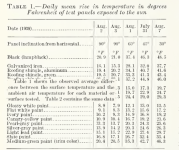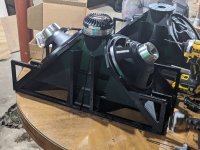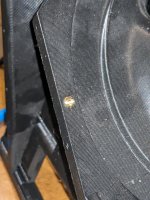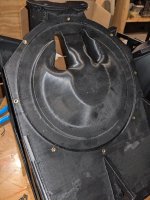@rrobot For some reason the "quote" function stopped working.
While our new printer could print a one-piece top, we decided to go with producing "plugs" we could use for the existing prints. We can post the STL for the plugs when done. Seemed easier than tossing the baby out with the bathwater...
We did use M6s for the compression driver. We used a 3/4" plastic screw for the chassis/horn, using 1/8" pilot. Obviously there's not a ton of purchase for the plastic parts so go easy on the torque... Here's the screw we used: https://www.mcmaster.com/95893A725/
You might be able to use a 1" but watch the blind holes.
If we're happy with how our plugs work we'll add those to the folder, if not we'll reprint the horn.
While our new printer could print a one-piece top, we decided to go with producing "plugs" we could use for the existing prints. We can post the STL for the plugs when done. Seemed easier than tossing the baby out with the bathwater...
We did use M6s for the compression driver. We used a 3/4" plastic screw for the chassis/horn, using 1/8" pilot. Obviously there's not a ton of purchase for the plastic parts so go easy on the torque... Here's the screw we used: https://www.mcmaster.com/95893A725/
You might be able to use a 1" but watch the blind holes.
If we're happy with how our plugs work we'll add those to the folder, if not we'll reprint the horn.
That's good thinking idea actually, and i guess if they're a tight enough friction fit to snap in and out (say if printed in TPU?) that also could permit you to utilise the ports where you need to run the horn without a sub, or to cross the sub below 100hz etc? Perhaps removable won't work due to air leaks, im not sure.. sounds like you have a solid plan anyway!While our new printer could print a one-piece top, we decided to go with producing "plugs" we could use for the existing prints
I'll be running a CDX14-3055 which does indeed use M6 bolts. I think from memory you were running a CDX14-3060 so im reasonably hopeful the throat transition on the printed horn is a good match.
That's awesome... cheers for the heads up on the screws! I was probably at risk of stripping with wood screws. I sliced the print with 4 layer perimeters and fairly low infill (15-20%) which I hope is sufficient to grab the screws due to the neat way you reinforced the holes in the print. Thanks again, this is extremely helpful! 🙂We used a 3/4" plastic screw for the chassis/horn, using 1/8" pilot.
4) As Art noted, skip the large ports on the horns if you can. Adding the kickers to our system eliminated the need for the ports, and removing the ports slightly decreased THD on the tops. We are going to reprint the interior without the ports.
Hi,
A question about removing the ports, cos I've seen this mentioned here and there but there's something that's not clear to me...
Does 'removing the ports' refer to ports 1 - 4 in this picture, or ports 5 - 8?
We just purchased some of the Eminence 314x carbon compression drivers for the tops, very smooth response and excellent dynamics, on paper. Will share once the drivers are installed.
It'd be pretty difficult to make one to snap in and out, I think, but our system just travels with the kickers anyhow. We'll be gluing in place, then repainting the horn. It was showing some wear and tear anyhow.That's good thinking idea actually, and i guess if they're a tight enough friction fit to snap in and out (say if printed in TPU?) that also could permit you to utilise the ports where you need to run the horn without a sub, or to cross the sub below 100hz etc? Perhaps removable won't work due to air leaks, im not sure.. sounds like you have a solid plan anyway!
We're in the Midwest and have no desire to run or transport these in hot environments. The closest these will get to the Playa is the West Michigan equivalent here at Lakes of Fire (the Regional Burn out this way), and the temps there are pretty temperate. Climate change may see this change though, as the summers aren't getting any cooler :/PLA is risky because it's easily softened by temps you find in the desert/hauling the system in a truck in the desert.
We used a carbon PETG for the tops, I think PETG would work too.
PLA filament starts to soften ~60 Celsius, 140 degrees Fahrenheit.We're in the Midwest and have no desire to run or transport these in hot environments.
Does not have to be too hot to reach that level inside a speaker cabinet.
Detroit is predicted to reach 87F tomorrow.
Temperature of a black surface in the sun can rise over 48 degrees over the ambient temperature:
Temperature inside a speaker cabinet can easily rise another 25 degrees due to voice coil heat:
87+45 +25=160, PLA started to soften about 20 degrees below that 😱.
Better keep those PLA cabinets in the shade, or they might look like this Salvador Dali painting 😉
Here in New Mexico, on a hot, sunny, summer day, a black surface that reflects 5 percent of the sun’s energy and emits more than 90 percent of the heat it absorbs can reach 180°F (82°C).
I have persistent memories of burning my fingers picking up stage equipment in the summer sun..
Art
Attachments
Ruroh.. well, I may have to revisit printing these in ABS (I certainly have enough of it lying around now), or use a friends CNC to shape the horn parts from plywood.
I did have a thought filling the prints with a polyurethane foam or other filler since I've printed them with gyroid pattern infill resulting in a contiguous volume. This would potentially eliminate the need for the PLA to be structural?
I'll plan on them failing at some point, at which point it'll be a plan B situation. It would be a shame though if this were to happen during a show, but I'm (morbidly) curious to know how they'd sound when that happens..
Re fasteners: I used M6 hex bolts to fix the B&C CDs, and M4 hex bolts into heat-set inserts which worked a charm, and seems to allow for a good amount of torque.
I did have a thought filling the prints with a polyurethane foam or other filler since I've printed them with gyroid pattern infill resulting in a contiguous volume. This would potentially eliminate the need for the PLA to be structural?
I'll plan on them failing at some point, at which point it'll be a plan B situation. It would be a shame though if this were to happen during a show, but I'm (morbidly) curious to know how they'd sound when that happens..
Re fasteners: I used M6 hex bolts to fix the B&C CDs, and M4 hex bolts into heat-set inserts which worked a charm, and seems to allow for a good amount of torque.
I had a line array with 28 eight inch mid drivers on multiple entry horns the same size as the SynTripP.It would be a shame though if this were to happen during a show, but I'm (morbidly) curious to know how they'd sound when that happens..
On one set up heard a bit of distortion that sounded like a ripped cone, but I was not able to isolate it to a specific cabinet.
When individually tested, I found one driver with slightly loose screws, the air leak was responsible for the noise.
A small air leak not only sounds buzzy, but comes with a loss in level.
PETG is the way to go. ABS is pretty awful for large parts, too much deflection, you'll have an awful time with plate adhesion.Ruroh.. well, I may have to revisit printing these in ABS (I certainly have enough of it lying around now), or use a friends CNC to shape the horn parts from plywood.
I did have a thought filling the prints with a polyurethane foam or other filler since I've printed them with gyroid pattern infill resulting in a contiguous volume. This would potentially eliminate the need for the PLA to be structural?
I'll plan on them failing at some point, at which point it'll be a plan B situation. It would be a shame though if this were to happen during a show, but I'm (morbidly) curious to know how they'd sound when that happens..
Re fasteners: I used M6 hex bolts to fix the B&C CDs, and M4 hex bolts into heat-set inserts which worked a charm, and seems to allow for a good amount of torque.
PLA is not recommended, we would never use it for anything used outdoors or transported.
Apparently the glass fiber reinforced ABS has a lot less deflection than standard ABS. You need a hardened nozzle to print it, but it could be a great choice as well. More details here:
We used carbon-reinforced PETG for even lower deflection, PETG is just less prone to lifting during large prints, at least in our experience.
We did end up with a crack (that we could repair) when the whole ~400lb stack got blown over by a dust devil, but that was easy enough to repair, some epoxy and a new rattle can did the job.
We did end up with a crack (that we could repair) when the whole ~400lb stack got blown over by a dust devil, but that was easy enough to repair, some epoxy and a new rattle can did the job.
Hello!
We are almost done with out subwoofer build, so we are finalyl gettign around to building these babies! Already haev a few parts at hand.
Got a question though: Do you think sealing/painting the inside of the cabinet with some paint is neccessary? For our subs we did that as they have a huge port and move a lot of air. To circumvent the wood warping or swelling due to moisture. Or do you think painting the outside/visible areas is enough?
Cheers!
We are almost done with out subwoofer build, so we are finalyl gettign around to building these babies! Already haev a few parts at hand.
Got a question though: Do you think sealing/painting the inside of the cabinet with some paint is neccessary? For our subs we did that as they have a huge port and move a lot of air. To circumvent the wood warping or swelling due to moisture. Or do you think painting the outside/visible areas is enough?
Cheers!
Painting the outside/visible areas is usually enough to circumvent the wood warping unless the inside will actually get wet.
I suspect you'll probably be ok as long as you avoid too much heat and keep direct UV off the PLA.. but it'll be most vulnerable at the compression driver attachment maybe? That was the issue I've personally found with a few PLA printed horns.. the mounting bolts kept loosening, presumably because the PLA crept a bit.I'll plan on them failing at some point, at which point it'll be a plan B situation
We used bamboo ply for the exterior cabinets. Tough as heck and super stable.
I notice quite a few folks here using Hypex NC252MP on the compression drivers chasing lower distortion amd noise. Id welcome opinions about whether any of the higher end diy TPA3255 modules could reasonably be substituted? They are pretty close to hypex in SINAD performance but a bit lower on power. In dual mono with a 48v 5A supply i think we can get close to 130w RMS per side into 8 ohms (fosi, 3E, Sylph etc) . That doesn't really give us much headroom though does it?
- Home
- Loudspeakers
- Multi-Way
- SynTripP: 2-way 2-part Virtual Single Point Source Horn



